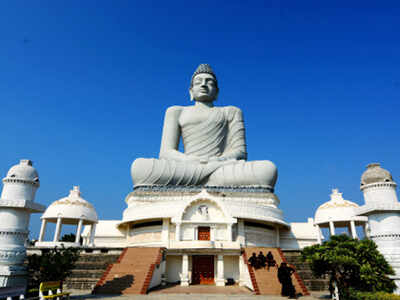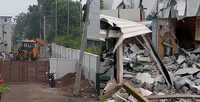
HYDERABAD: Is Andhra capital Amaravati being built on a Buddhist burial site ?
Prominent historians from Andhra Pradesh differ with Captain L Pandu Ranga Reddy, a member of Royal Historical Society and who hails from Telangana, on the issue. L Pandu Ranga Reddy, quoting British historian Charles Allen, said that Amaravati was never the capital of any king, and it was just a necropolis.
He said building a capital city on a necropolis has brought ill-luck to Telugu Desam Party chief N Chandrababu Naidu and cautioned the new chief minister, YS Jaganmohan Reddy.
However, Andhra historians, who did extensive research on Amaravati, said it was capital for three kings of Satahvahana and Pallava dynasty, and that Dhanyakataka, Dharanikota and Amaravati were one and the same place. They said that like any other urban city in the present age, Amaravati too had a necropolis, and no capital building is coming up there.
They refuted comments of Pandu Ranga Reddy stating that Amaravati was and is the pride of Andhra Pradesh, and many inscriptions, sculptures prove it. Pandu Ranga Reddy said, “I said in 2015 that a capital on a necropolis would bring bad luck to the party in power. The poll results declared on May 23 have vindicated my assertion. The capital of Satavahanas was Paithan (in Maharashtra), and when they were defeated by the Kshatrapas, they came to Dhanyakataka, but not Amaravati. Amaravati was never a political seat for any dynasty in Indian history. In 1797 Colonel McKenzie, surveyor of Madras Residency, while making a topographic survey of the country south of the Krishna river in eastern Andhra Pradesh, received a report of ‘antiquities’ uncovered by a local zamindar named Venkatadri Naidu. McKenzie lost no time in moving to the place and found a vast circular mound composed entirely of large bricks. He named the area Amarapura in February 1797. In the course of time, it came to be known as Amaravati.”
He added that at this place, many stupas were found. “A stupa is an edifice built over the relics of Buddha or monks. That’s why this place is a necropolis. YSRC should shift the secretariat and assembly to Kondaveedu. Among the dynasties which ruled Andhra Pradesh, the Kakatiyas and the Kondaveedu were only true Telugu kingdoms.”
Noted historian, E Sivanagi Reddy, said, “Amaravati was a great international centre of Buddhism for nearly 1,700 years from 3rd Century BC to 14th Century AD, which is from the Mauryan to the Kakatiya Period.”
Prominent historians from Andhra Pradesh differ with Captain L Pandu Ranga Reddy, a member of Royal Historical Society and who hails from Telangana, on the issue. L Pandu Ranga Reddy, quoting British historian Charles Allen, said that Amaravati was never the capital of any king, and it was just a necropolis.
He said building a capital city on a necropolis has brought ill-luck to Telugu Desam Party chief N Chandrababu Naidu and cautioned the new chief minister, YS Jaganmohan Reddy.
However, Andhra historians, who did extensive research on Amaravati, said it was capital for three kings of Satahvahana and Pallava dynasty, and that Dhanyakataka, Dharanikota and Amaravati were one and the same place. They said that like any other urban city in the present age, Amaravati too had a necropolis, and no capital building is coming up there.
They refuted comments of Pandu Ranga Reddy stating that Amaravati was and is the pride of Andhra Pradesh, and many inscriptions, sculptures prove it. Pandu Ranga Reddy said, “I said in 2015 that a capital on a necropolis would bring bad luck to the party in power. The poll results declared on May 23 have vindicated my assertion. The capital of Satavahanas was Paithan (in Maharashtra), and when they were defeated by the Kshatrapas, they came to Dhanyakataka, but not Amaravati. Amaravati was never a political seat for any dynasty in Indian history. In 1797 Colonel McKenzie, surveyor of Madras Residency, while making a topographic survey of the country south of the Krishna river in eastern Andhra Pradesh, received a report of ‘antiquities’ uncovered by a local zamindar named Venkatadri Naidu. McKenzie lost no time in moving to the place and found a vast circular mound composed entirely of large bricks. He named the area Amarapura in February 1797. In the course of time, it came to be known as Amaravati.”
He added that at this place, many stupas were found. “A stupa is an edifice built over the relics of Buddha or monks. That’s why this place is a necropolis. YSRC should shift the secretariat and assembly to Kondaveedu. Among the dynasties which ruled Andhra Pradesh, the Kakatiyas and the Kondaveedu were only true Telugu kingdoms.”
Noted historian, E Sivanagi Reddy, said, “Amaravati was a great international centre of Buddhism for nearly 1,700 years from 3rd Century BC to 14th Century AD, which is from the Mauryan to the Kakatiya Period.”
World Cup 2019
Trending Topics
LATEST VIDEOS
More from TOI
Navbharat Times
Featured Today in Travel
Quick Links
Lok Sabha Election Schedule 2019Lok Sabha Election NewsDelhi Capitals teamMI team 2019Rajasthan Royals 2019RCB team 2019Maharashtra Lok Sabha ConstituenciesBJP Candidate ListBJP List 2019 TamilnaduShiv Sena List 2019AP BJP List 2019Mamata BanerjeeBJP List 2019 MaharashtraPriyanka GandhiBJP List 2019 KarnatakaAMMK Candidate List 2019BJP List 2019 WBLok Sabha Elections in Tamil NaduBSP List 2019 UPNews in TamilLok Sabha Poll 2019Satta Matka 2018PM ModiMahagathbandhanNagpur BJP Candidate ListChandrababu NaiduTamil Nadu ElectionsUrmila MatondkarNews in TeluguMadras High CourtTejashwi YadavArvind KejriwalTejasvi SuryaPawan KalyanArvind KejriwalYogi AdityanathJaya PradaSatta King 2019Srinagar encounter
Get the app









